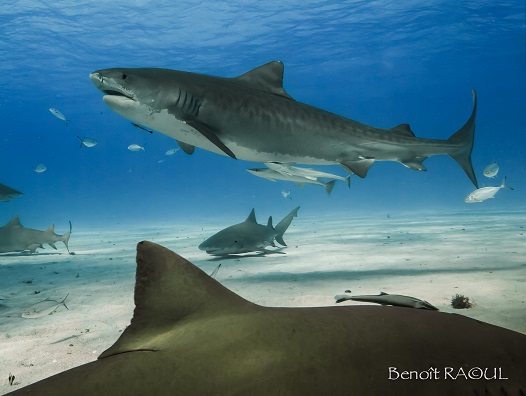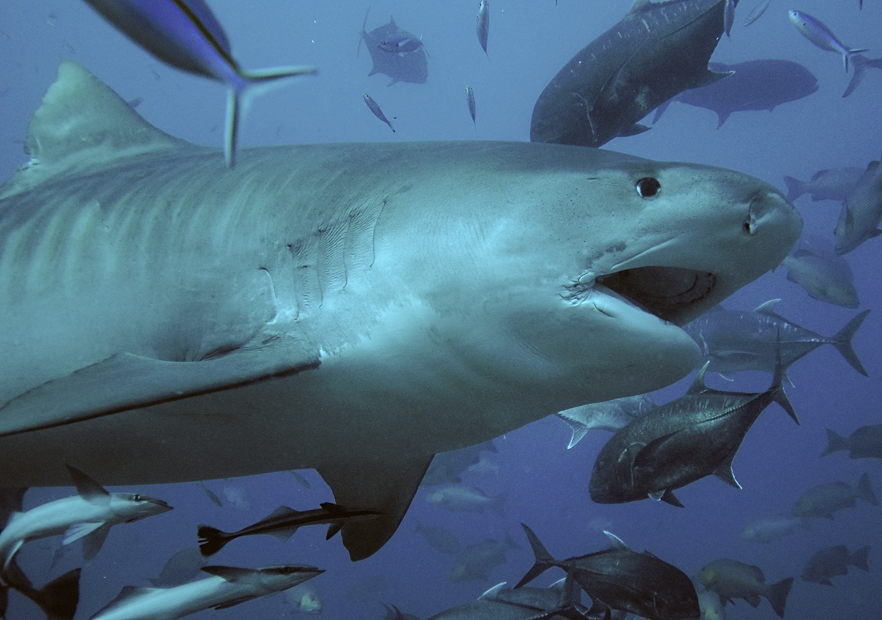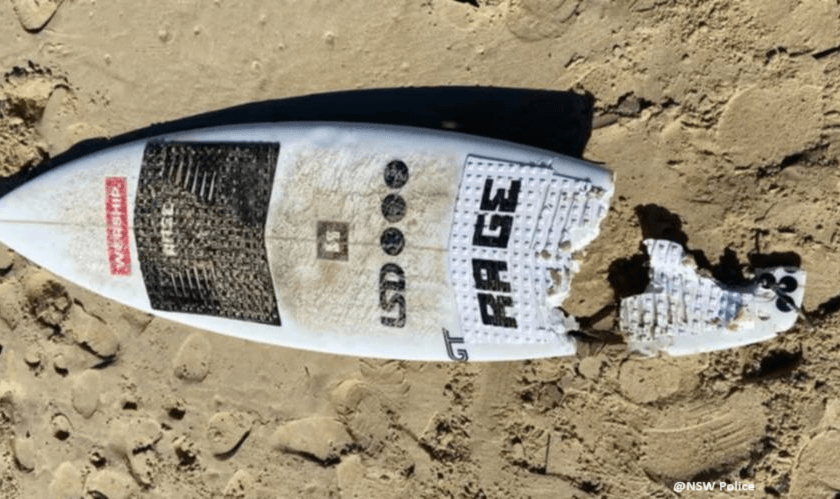We return to Scuba diving on Tiger Beach, Bahamas Part 2.
Part 1 can be found here.
The news that the first tiger shark is now swimming below has disconcerted everyone at the lunch table. Now it’s a frantic rush onto the dive deck of the Bye Polar, because this is the moment all the guests have waited for.
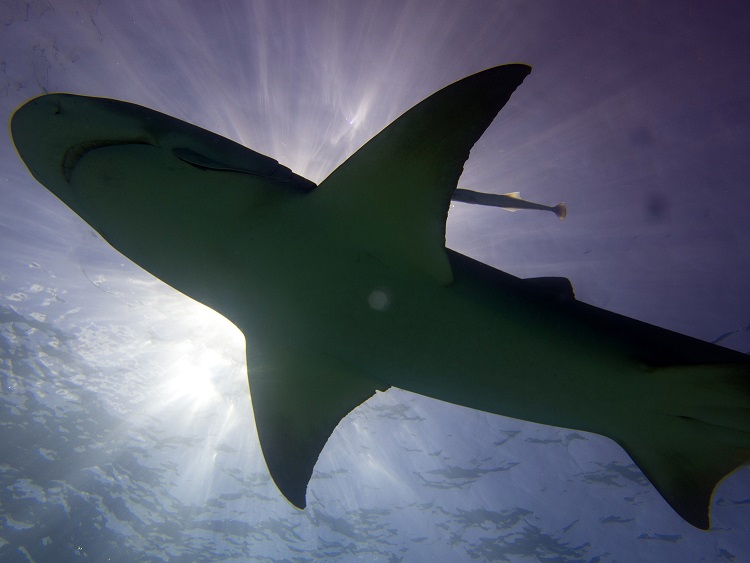
The dive crowd on the platform is curious, and everyone’s eyes are searching. Only the silhouettes of the lemon sharks are clearly visible. Fifteen or more might be there now. A lemon shark can be easily recognized by its second dorsal fin which, unlike other shark species, is almost as large as the first fin.
Lemon sharks are big and mean-looking and appear in dire need of an orthodontist. Their spiky teeth are very much in evidence. They’re very much like the sharks in Finding Nemo.
However, tiger sharks are macropredators that can attain a length over 5m (16 ft 5 in), and are one of the largest sharks in the world.
Even at the last dive after breakfast, a real clump of shark bodies formed around the perforated bait box. The dead fish in the box are not accessible to the sharks, and so they circle around and get excited, always the smell of blood in their nose.
Slowly the guests glide into their wet suits. The view is always focused down into the water. No trace of the tiger. The first encounter with a tiger shark was, of course, the subject on board, since the time the ship left Coconut Grove. Now, just before the big leap, everyone is a bit queasy.
The inner tension can be felt. Hardly anyone says a word and the smiles have disappeared. Then it’s time to descend directly to the bottom. The current has been somewhat overloaded and carries a lot of suspended particles. Thus, the visibility has deteriorated significantly.
We squeeze down in a semicircular formation around the bait box. A handsome number of lemons circle around the box and between the divers. However, there is still no sign of the tiger shark.
Our guide, Martin, floats to the food box and opens it for a brief moment. Some small chunks are carried away by the current. Immediately movement comes into the pack. Due to the sharks‘ fast activity close to the bottom, much sediment is swirled up, which further deteriorates visibility.
He opens the basket one more time and releases a few appetizers.
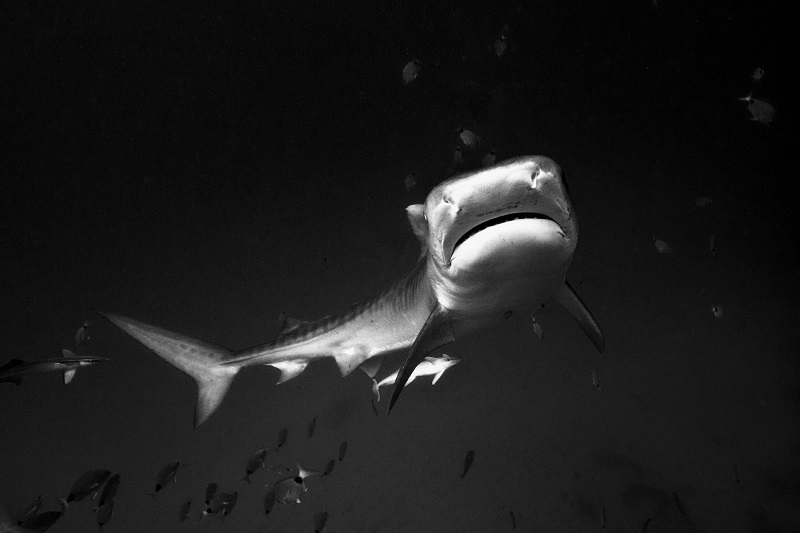
Then the tiger is there. As if she came out of nowhere, slowly, and without any hustle and bustle, she swims between the lemon sharks toward the bait box, very close to Martin.
She is big, really, respectably big. The eyes of the divers are still fixed on her. After a few laps around the bait box, she passes the full length of the group. The typical pattern on its flanks is already somewhat faded, but is still recognizable.
Again she takes course to the bait box. Martin takes a big fish head out. Without changing its speed, the tiger aims toward the bait. A lemon shark takes its chance, but it‘s slightly faster and snaps the fish head. The tiger bumps into him and wants to grab the competitor. The lemon shark immediately drops the bait. This clearly shows who is the boss here at the lunch table.
Martin continues to play the game for a while. The powerful shark swims a few larger circles and sometimes disappears because of the bad visibility. Suddenly, however, she appears again. She scrutinizes the bubbling creatures, but her distance decreases further.
Not even 50 centimeters (20 in) separate the tiger shark from the first diver of the group. His adrenaline level certainly reaches a peak. Slowly the colossus moves on, swimming directly across the heads of some the divers.
When she is almost out of sight, the gestures of the divers indicate what is going on in their heads: That was close! Later, back on board, when nerves slowly reach the normal range, one can look into very happy faces. Shortly before the dive we had seen a few dolphins from the boat. Where dolphins are, there are no sharks around, or at least that’s what was wrongly told us in the TV show Flipper.
The next dive:
It is astonishing. The tiger shark approaches the bait rather slowly and carefully. Bustle is not her thing. The movements are slow, but she is purposeful and has a powerful force when the bite takes place.
When an audacious lemon shark snatches the bait out of the tiger shark‘s jaws, the pack comes into rage. Only a fraction of a second later she snaps her huge jaws into the back of the lemon shark. A loud cracking sound, like someone breaking off a rotten branch in a forest, can be heard.
The battered lemon shark swims away, presumably with a broken neck; if he survived it, we do not know. Abruptly, I am aware of the law that the strongest that dominates rules below, and that law is the tiger shark.
Tiger sharks have been called the bad guys and the villains of the seas. The sharks are considered to be the most dangerous predators in the tropics. They have the most perfect, and at the same time, the most horrifying bite of all sharks. Its bite strength is so great it can crack any turtle shell with ease.
Have you ever wondered how we have any sea turtles left in our oceans? Surely, as the years have passed, all these slow moving, tasty morsels of goodness would have nearly been consumed by the more agile and powerful shark. I mean, really, other than a hard shell which tiger sharks have little problem sawing through with their well suited teeth, what chance do sea turtles have?
It turns out sea turtles have some clever defenses they use to avoid being taken by a shark.
Firstly, when approached by an inquiring shark, the sea turtle will often present its full, flat shell toward the shark. Instead of being horizontal like a flat cookie which the shark can easily bite through, it will stay in a half-roll upright position and the shark will not be able to open its mouth wide enough to bite into the large, broad surface of the shell.
Secondly, the turtle will stay very close to the shark and will keep swimming in a tight circle around the shark. Because the shark will not be able to match the tight radius, it will not be able to latch onto the turtle.
Tiger sharks are not as picky eaters as white sharks who prefer hunting seals and tuna fish. They examine everything that swims and floats as if it could be food. The wide food spectrum allows the tiger shark to survive in all seas.
They are particularly successful in hunting large waterbirds such as albatrosses. Tiger sharks can pose a danger for swimmers and bathers. They have an established preference to rise from the depths at dawn and dusk to go hunting, make evening bathing trips an incalculable risk.
To be continued in Part 3, Scuba diving on Tiger Beach, Bahamas.

Christian Kemper is a TV journalist from Germany. He has been diving with and studying sharks for more than 20 years. He has written two books about shark attacks and one book about crocodiles. He is a freelance writer for three of the biggest diving magazines in Germany.
You can find his German Language book Strange Pool Friends on Amazon and at tredition.
